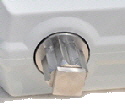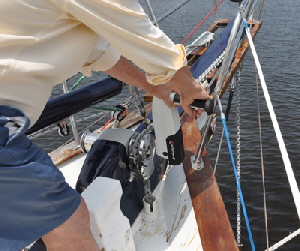 Britannia has a cordless battery powered winch winder that can be used on all thirteen winches.”
Britannia has a cordless battery powered winch winder that can be used on all thirteen winches.”
 The Ewincher will spin a winch at up to 100 rpm, that is much faster than anyone can continuously turn a winch by hand.
The Ewincher will spin a winch at up to 100 rpm, that is much faster than anyone can continuously turn a winch by hand.
Rotation speed is controlled by a button on the vertical handle and is proportional, the harder you press the faster it turns. Rotation can be reversed by simply pressing another button on the handle, that brings in the lower gearing for a two-speed winch.
A major benefit of the Ewincher2 is its detachable 25-volt lithium-ion batteries, because reefing a roller furling mainsail is not the time to discover that the battery is about to die. With a removable battery you can quickly slide a fully charged one in place without even removing the Ewincher2 from the winch. The dead battery can then be charged on your boat in about one hour from either a 120/240 volt or a 12 volt source. A series of different colored lights show the condition of the battery both on the winder and when being charged. The kit comes with a very smart carrying bag, battery chargers from both 120-volt and 12-volt sources, a storage pouch and a hand strap. Batteries are available in black and yellow.
Ewincher2 can also be cranked by hand like a regular handle and it also ratchets. If the battery is low, or the load is exceptionally heavy, the machine can be helped by hand winding and the handle is long enough to be gripped with two hands. This acts a bit like power assisted steering on a car that makes turning the wheel so much easier.

 Another important feature is that the Ewincher2 winch pinion is spring loaded to automatically lock when pushed into a winch like most manual winch handles. This makes using it in horizontal mast winches much safer, without fear of it falling out of the winch.
Another important feature is that the Ewincher2 winch pinion is spring loaded to automatically lock when pushed into a winch like most manual winch handles. This makes using it in horizontal mast winches much safer, without fear of it falling out of the winch.
Amazingly, the torque of the Ewincher2 can be adjusted from an app’ on an I-phone. This can save battery life and the state of charge can be seen on the phone along with the remaining run time. Lowering the torque is helpful as it reduced the counter rotation force of holding the handle.
 I put the Ewincher2 to good use on a short cruise in the Pamlico Sound of North Carolina, where it operated the sails effortlessly. When we were ready to weigh anchor in the morning at our first overnight anchorage I decided to give it what I thought would be the ultimate test on my 22-ton schooner, and find out just how powerful the thing was. This was not on a winch but on my Maxwell windlass, to haul in 100’ feet of 3/8” inch chain with a 65 lbs. CQR on the end. I plugged the Ewincher2 into the hand cranking socket on the windlass and pressed the button. The machine turned the gypsy easily enough, but it took some getting used to because the socket is offset so any hand-cranking lever operates non concentrically. It steadily hauled the chain in then even swung the big anchor over the bow roller onto its bed with a resounding clunk as much as to say, “What do you think of that then?” or more probably, "Que pensez-vous de cela alors?" It's just good to know that it works if ever it becomes necessary to hand crank the windlass. Another method of weighing anchor is to use a chain claw on a rope around a winch, after all they are now all electric.
I put the Ewincher2 to good use on a short cruise in the Pamlico Sound of North Carolina, where it operated the sails effortlessly. When we were ready to weigh anchor in the morning at our first overnight anchorage I decided to give it what I thought would be the ultimate test on my 22-ton schooner, and find out just how powerful the thing was. This was not on a winch but on my Maxwell windlass, to haul in 100’ feet of 3/8” inch chain with a 65 lbs. CQR on the end. I plugged the Ewincher2 into the hand cranking socket on the windlass and pressed the button. The machine turned the gypsy easily enough, but it took some getting used to because the socket is offset so any hand-cranking lever operates non concentrically. It steadily hauled the chain in then even swung the big anchor over the bow roller onto its bed with a resounding clunk as much as to say, “What do you think of that then?” or more probably, "Que pensez-vous de cela alors?" It's just good to know that it works if ever it becomes necessary to hand crank the windlass. Another method of weighing anchor is to use a chain claw on a rope around a winch, after all they are now all electric.
I wanted to make a heavy load test, that other sailboat owners will never need to do. Britannia is a brigantine schooner with a squaresail 35’ feet up the foremast. The yard and sail weighs 140 lbs. and we occasionally lower it to reduce windage. Winding it back up the mast by hand is hard work with its single block on a horizontal winch, but the Ewincher2 effortlessly hauled the assembly up the mast in a few  minutes.
minutes.
There are other tasks an Ewincher2 can be used for: Like hoisting a dinghy up on davits and you won't use those slow hand tackles ever again. Just run your lines back to a winch and the machine will hoist the dinghy and outboard complete in no time.
Young people and women can now wind any winch as fast as the men. The Ewincher2 comes with a neat storage cradle that can be attached to any flat surface in the cockpit using two 4“ inch wide Velcro strips that saves drilling holes. Everyone then knows where to find the machine.
the Ewincher2 website is www.ewincher.com and there are videos on Facebook and other social media sites.
